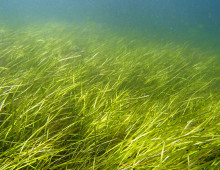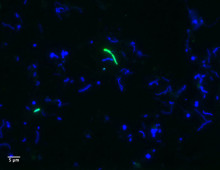First marine flowering plant genome provides clues on how crops could adapt to saline environments. To mitigate carbon emissions in the atmosphere, researchers have turned to sinks–reservoirs that accumulate and store carbon such as tropical rainforests, but also including a variety of terrestrial plants as well as oceans. However, another lesser known but very large…
Uncovering Hidden Microbial Lineages from Hot Springs
Metagenomics and single cell strategies help reveal a novel bacterial phylum. Although global microbial populations are orders of magnitude larger than nearly any other population in, on or around the planet, only a fraction has been identified thus far. The U.S. Department of Energy (DOE) is seeking to uncover the true extent of the planet’s…
Highly Cited: 8 DOE JGI Researchers Make 2015 List
Millions of researchers worldwide publish millions of papers. Thomson Reuters compiles a Highly Cited Researchers database, listing based on the number of citations their work has received from fellow researchers. Among the factors that play into the database is the Essential Science Indicators in Web of Science, which tracks papers published in the past decade that rank in the…
Genomic Basis for Herbivore Gut Syntrophy
Anaerobic fungi are found in the rumen or hindgut of large herbivores, where they partner naturally with methanogenic archaea in a type of symbiotic relationship known as syntrophy. In this mutualistic relationship, methanogens siphon off and utilize fungal waste products (hydrogen and carbon dioxide), thereby speeding fungal metabolism and enabling faster and more complete deconstruction…
Microbial Nitrogen Cycling along the Colorado River
Extensive uranium groundwater contamination at DOE’s legacy ore processing sites has resisted extensive remediation attempts. One of these sites lies within the upper Colorado River Basin. The sediments here are referred to as naturally reduced zones (NRZs) because they are generally nutrient-poor and have abundant iron sulfide minerals. There is concern that NRZs are acting…
A Pathobiome Database for Bioenergy Trees
Poplars and pines have been plant flagship agro-forestry crops for bioenergy production, resulting in large amount of resources being devoted to its production and improvement. One of the most important threats to the sustainable growth of trees in plantation is attack by pathogens. Two important aspects in preventing outbreaks are early detection, monitoring and surveillance….
Early Diverging Lineages of Fungi
Fungi inhabit most of the world’s ecological niches where they perform numerous services that are central to ecosystem functioning. Despite significant advancements in our understanding of the evolutionary relationships within Kingdom Fungi, the earliest diverging events are still very poorly understood. Resolving the earliest branches in the Kingdom Fungi is essential to identify the characteristics…
Snow Algae Comparative Genomics
Temperature is one of the most important abiotic determinants of the vitality, viability and distribution of life forms and therefore the biology of cold-adapted organisms is of broad general interest. As polar temperatures rise, the permanent frozen portion of the Arctic is shrinking, as is the geographical region with a summer average of 10ºC, which…
How Ascomycetes Degrade Plant Biomass
Aspergilli are generalist species that are able to consume a broad range of substrates. In contrast, species such as P. anserina are much narrower in their substrate utilization profile, which correlates with its biotope on herbivore dung. The soil fungus T. reesei is an intermediate species, which has a broader biotope range than P. anserina,…
Modeling Brachypodium-Trichoderma symbiosis
Secondary metabolites are a heterogeneous group of natural compounds that are considered to aid the producing organism in survival and basic functions. Trichoderma spp. are known to produce over 200 secondary metabolites, of which many have been found to have biological activity on plants, microbes and substrates. Among these metabolites, polyketides have important biological activities…


